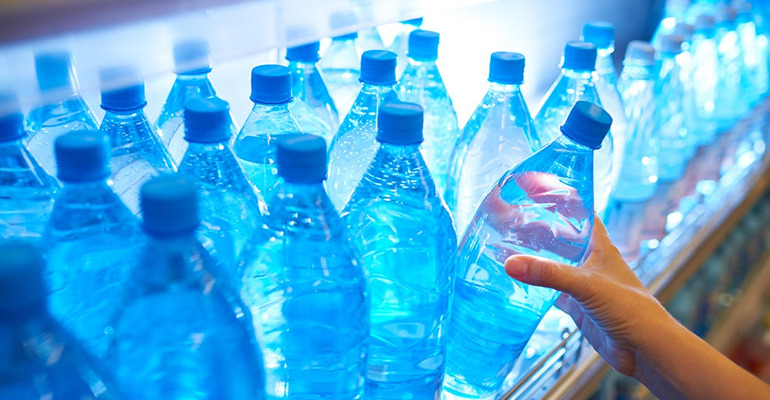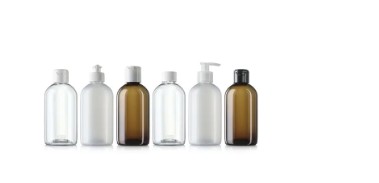Bottled water reaches new peaks in revenue and volume: 15.9 billion total gallons sold in 2022 was the highest ever as sales approached $46 billion.
Americans are drinking more than ever, at least for the most basic of packaged liquids, bottled water. In fact, when it comes to hydration, US consumers would rather reach for bottled water than for a faucet.
According to new data from the Beverage Marketing Corp. (BMC), bottled water reached new peaks in both volume consumed and sales in 2022 in the US.
Bottled water’s total volume sold in 2022 was 15.9 billion gallons, its highest volume ever, surpassing carbonated soft drinks for the seventh year in a row. In terms of retail dollars, 2022 sales approached $46 billion, up from $40.8 billion in 2021.
“Numerous qualities account for bottled water’s unceasing resonance with US consumers, including its associations with healthfulness, convenience, safety, and value,” says John G. Rodwan, Jr., BMC’s editorial director. “Consumers’ thirst for beverages that offer benefits beyond refreshment alone also contributed to the fundamental hydrating beverage’s rise in the beverage standings. Bottled water’s zero-calorie status and its lack of artificial ingredients appeal to many consumers. Even where tap water may be safe and readily available, people may prefer bottled water, which they often believe tastes better.”
For more than a decade, consumers have been increasingly choosing bottled water instead of less-healthy packaged drinks. Bottled water’s volume surpassed soft drinks for the first time in 2016 and has done so every year since.
Americans consumed, on average, 46.5 gallons of bottled water in 2022, compared to 36 gallons of soda. Consumer demand for bottled water has significantly contributed to the industry’s growth (30% since 2012), as people continue to switch from other less-healthy packaged drinks to bottled water. So much so, that nine out of 10 Americans (91%) want bottled water to be available wherever other drinks are sold, according to a survey conducted on behalf of the International Bottled Water Association (IBWA) by The Harris Poll.
Why do Americans prefer bottled water versus readily available tap water?
We posed that question to ChatGPT and this is what the artificial intelligence app reported:
People may have various reasons for preferring bottled water over tap water. Some common reasons include:
Perceived purity: Bottled water is often marketed as pure and clean, which can lead people to believe it is safer and healthier than tap water. They may perceive bottled water as being free from contaminants, chemicals, or additives that they believe could be present in tap water.
Taste and odor: Some individuals find that bottled water has a more appealing taste and lacks any unpleasant odors that they might associate with tap water. Bottled water companies often use filtration methods or source water from specific locations, which can result in a different taste profile.
Convenience and portability: Bottled water provides convenience and portability, allowing people to have access to water on the go. It is readily available in various sizes and can be easily carried in bags or taken to places where tap water might not be easily accessible or trusted, such as during travel or outdoor activities.
Safety concerns: In certain regions or situations where the quality of tap water is a concern, people may choose bottled water as a perceived safer alternative. This can be due to issues such as water contamination, infrastructure concerns, or inadequate water treatment systems in some areas.
Marketing and branding: Effective marketing campaigns by bottled water companies have created a perception that bottled water is a premium product associated with quality and purity. The branding, packaging, and labeling of bottled water can influence consumer preferences and choices.
As an aside, three takeaway reminders for me as a B2B packaging editor per ChatGPT’s marketing and branding comment:
- Never underestimate the power of packaging, especially for a commodity as common as water;
- Don’t overlook the influence of marketing; and
- Perception is everything.
Image courtesy of Antonio Sáez Caro/Alamy Photo Stock
IBWA says added benefit is that bottled water packaging is 100% recyclable.
“People are choosing to drink bottled water because it is a healthy beverage choice, having zero calories and no caffeine or additives, and it has the added benefit of packaging that is 100% recyclable,” says Jill Culora, IBWA’s vice president of communications. “Not only are bottled water containers 100% recyclable — including the cap — but they also use much less plastic than soda and other packaged beverages.”
Soda containers, on average, use 252% more PET plastic than bottled water containers (22.2 grams vs. 8.8 grams for 16.9-ounce containers). Soft drinks and other sugary beverages need thicker plastic containers due to their carbonation and/or bottling processes.
Even with continuing growth and increased consumption, bottled water still has the smallest impact on the environment—thanks to the fact that it has the smallest water and energy use footprint of any packaged beverage. On average, only 1.39 Liters of water (including the 1 Liter of water consumed) and 0.21 mega joules of energy are used to produce 1 Liter of finished bottled water.
Most bottled water is packaged in 100% recyclable PET #1 plastic and HDPE #2 plastic, which are the plastics most recognized by consumers as being recyclable and the most recycled plastics in the world. Consumers can be confident about recycling bottled water containers because they are among the few consumer packaging types that are universally recyclable across the US. Not all cities and towns recycle glass bottles and laminated paper cartons, which are usually comprised of multiple layers of paper, plastic, and aluminum or wax.
Culora tells us that there were no surprises from the latest study. “BMC keeps predicting continued growth and that is what we are seeing each year.”
PET bottles’ clear benefits vs. other plastic products and packaging.
The report summarizes the packaging benefits of PET bottles…
- Bottled water’s recyclability distinguishes it from other common plastic products that are truly “single-use,” such as non-recyclable plastic items such as straws, cutlery, and plates; certain food and goods packaging, for example, films and heat-sealed and multilayer laminate bags, and non-PET packaging.
- In addition, PET plastic bottled water containers are the most recognized by consumers as being recyclable, which is likely the reason why they are a valuable resource as the most recycled containers in US curbside recycling programs.
- Recycling facilities know that there is a huge industry demand for post-consumer PET and HDPE plastics. Many bottled water companies use recycled PET and HDPE plastic to create new bottles, which helps to reduce their environmental impact further because they aren’t using virgin plastic.
- Bottled water drinkers recycle more often than drinkers of other beverages. Of all the PET containers recycled through curbside collections systems, bottled water containers make up approximately 49%. Empty bottled water containers should always be returned or placed in a recycling bin, but when they are not, they make up 3.3% of all drink packaging that ends up in landfills, and only 0.02% of all landfill waste.
- Studies have shown that bottled water containers are also not a major source of ocean pollution and microplastics. A vast majority of ocean plastic comes from sources other than the US. In fact, if the US were to completely eliminate all plastic use, the effort would only result in a 0.25% reduction of ocean plastics, data from Oxford University’s Our World In Data website shows. A striking statistic is that bottled water accounts for less than 1.58% of all plastics used in the US, which means we are talking about 1.58% of 0.25%.
There’s also this NAPCOR study, PET Bottles Have Smaller Environmental Impact than Glass and Aluminum Containers, published in March.
“Consumer preference for healthy hydration and bottled water is really good news for public health,” says Culora. “This is particularly important as the nation continues to experience high rates of obesity, diabetes, and heart disease. Helping people make healthier choices is at the core of the bottled water business. Consumers have made it clear that there’s a demand for safe, healthy, and convenient bottled water, as they are responsible for propelling bottled water to the title of America’s most popular packaged beverage, by volume.”
IBWA encourages all consumers to make healthy hydration a part of their lifestyle and select bottled water as their beverage of choice and always recycle their empty containers—with the caps on.
Source:
https://www.packagingdigest.com/beverage-packaging/growing-thirst-bottled-water-us







